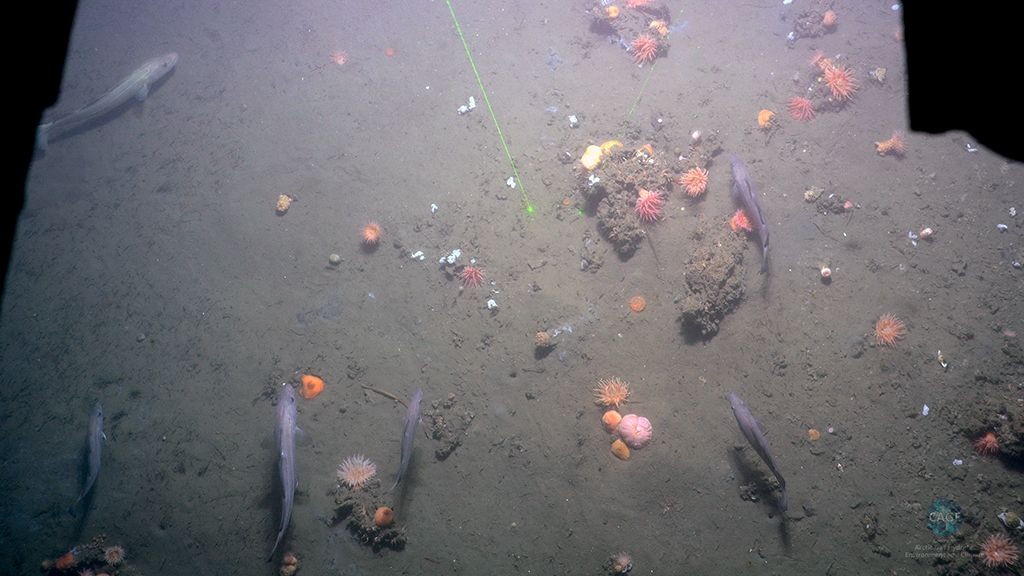Colorful Arctic Animals Revealed in Thousands of Undersea Images

New photographs of fluorescent sea creatures — including bright orange animals that resemble feather dusters with long, skinny handles, and spongy, neon-pink anemones — on the Arctic seafloor could help researchers determine how much methane, a potent greenhouse gas, will make its way to the atmosphere and contribute to climate change.
"When you think about the Arctic, these very cold and deep environments, you don't think about these colors, but some of these organisms are so colorful and beautiful. It's amazing," said Guiliana Panieri, a scientist on the photo-taking expedition and a professor in environment and climate at The Arctic University of Norway.
The colorful sea creatures live near methane seeps, or cracks in the ocean floor that naturally release methane. These seeps can form along continental margins and on the seafloor — all that's needed is organic matter, such as dead organisms, which release methane as they decompose. [See photos of the colorful creatures that lurk near methane seeps]
High-resolution cameras allowed researchers to capture the first-ever detailed images of the methane seeps on the Arctic seafloor. The scientists also collected samples of seep-dwelling organisms. "These samples will change our perspective," Panieri said.
The expedition collected more than 30,000 images of the seafloor. Panieri said researchers "will produce maps with the mosaic of the seafloor." She and her colleagues also plan to publish findings from the photos in the near future.
Icy crystals of gas
The Arctic poses myriad problems for even the most intrepid researchers, such as freezing temperatures, massive chunks of floating ice, gusty winds, ferocious waves and a giant price tag. Previous research focused on shallow methane seep communities, which are around 300 feet (90 meters) deep and are different from those on the seafloor, which are located around 3,960 feet (1,200 m) underwater, Panieri said. Although the main element in both environments is methane, this natural gas is more concentrated in deep settings because the deep water is isolated from waves that hit more shallow settings.
Sign up for the Live Science daily newsletter now
Get the world’s most fascinating discoveries delivered straight to your inbox.
Much of the methane in both shallow and deep Arctic settings comes from gas hydrates, which are methane molecules suspended in icy, crystalline cages. The methane hydrates form when methane released from buried organic matter reaches a point in the ocean with particularly high pressure and low temperature, trapping the methane in a chilly enclosure.
Methane hydrates are abundant in the frigid Arctic, and are dense in methane gas. "One cubic meter [35 cubic feet] of gas hydrate contains 164 cubic meters [5,790 cubic feet] of methane," Panieri said.
When the gas hydrate encounters water that is warmer and lower in pressure, it can start to melt, allowing methane to escape. As such, a very small amount of gas hydrate could send a huge amount of methane into the atmosphere, Panieri said.
Methane from the hydrates also fuels many of the chemosynthesizing organisms photographed on the Arctic seafloor. Chemosynthesizers use methane as a source of energy, unlike photosynthesizers, which convert light into energy. Panieri said that she and fellow researchers want to study the biology of the organisms that live around seeps, including species that chemosynthesize and species that live together with chemosynthesizers.
"We want to define and to calculate how much methane is consumed by these organisms," to then determine how much methane can escape to the atmosphere, Panieri said.
Looking to the past
To investigate past emissions of methane and the effects on ancient climate, Panieri is studying foraminifera — marine microorganisms with an enduring global presence. Their calcium-carbonate shells, or "tests," incorporate elements from the water column, and store them like a dateable fingerprint for water chemistry and methane content.
Understanding past methane concentrations could help researchers explain the cause of methane releases — ancient methane emissions may have resulted from geologic processes like earthquakes, or from climactic events that drove global temperatures up or down, the researchers said.
Panieri added that scientists are also "trying to understand if global warming affects the methane emissions in the Arctic," to see if there is a connection between warming climate and methane emissions. Although the relationship is still being investigated, Panieri said sea ice is melting and freeing more space for methane to travel up and out of the ocean, creating a more vulnerable climate system.
Elizabeth Goldbaum is on Twitter. Follow Live Science @livescience, Facebook & Google+. Original article on Live Science











